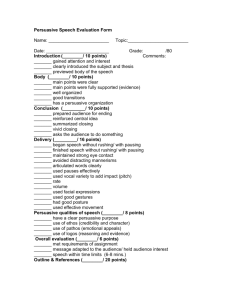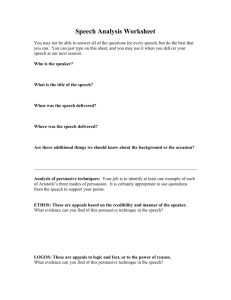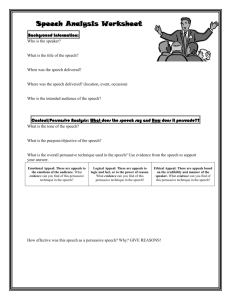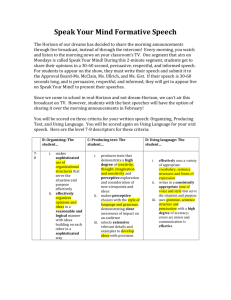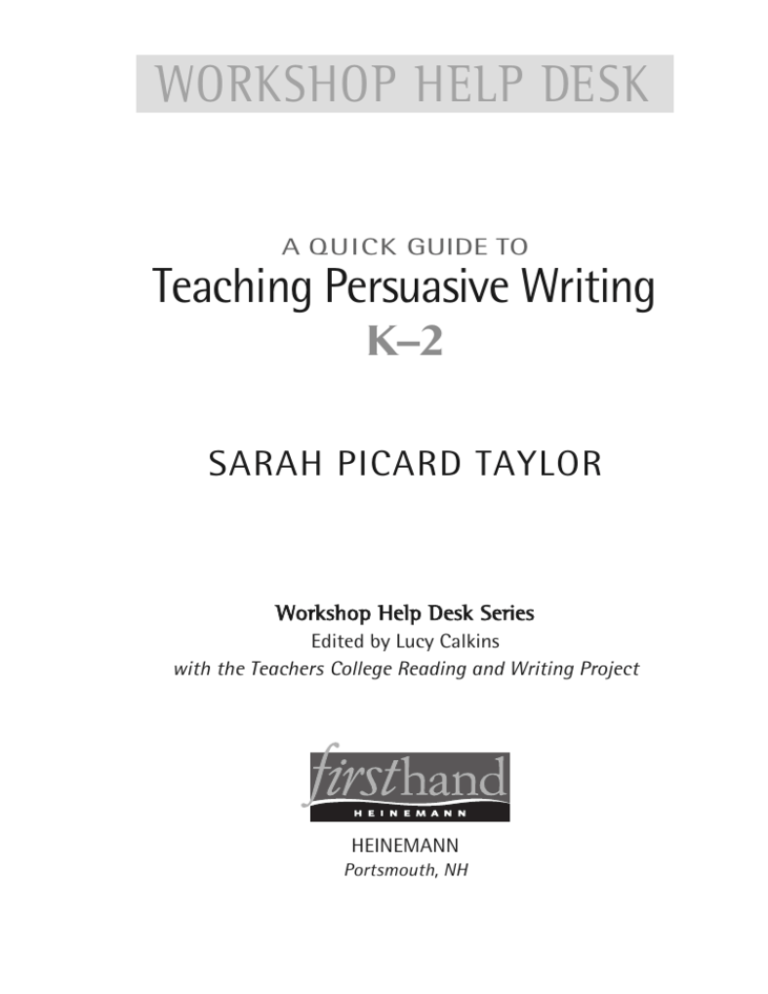
WORKSHOP HELP DESK
A QUICK GUIDE TO
Teaching Persuasive Writing
K–2
SARAH PICARD TAYLOR
Workshop Help Desk Series
Edited by Lucy Calkins
with the Teachers College Reading and Writing Project
HEINEMANN
Portsmouth, NH
An imprint of Heinemann
361 Hanover Street
Portsmouth, NH 03801–3912
www.heinemann.com
Offices and agents throughout the world
© 2008 by Sarah Picard Taylor
All rights reserved. No part of this book may be reproduced in any form or by
any electronic or mechanical means, including information storage and retrieval
systems, without permission in writing from the publisher, except by a reviewer,
who may quote brief passages in a review, with the exception of reproducibles
(identified by the Quick Guide to Teaching Persuasive Writing, K–2 copyright
line), which may be photocopied for classroom use only.
Library of Congress Cataloging-in-Publication Data
Taylor, Sarah Picard.
A quick guide to teaching persuasive writing, K–2 / Sarah Picard Taylor.
p. cm. — (Workshop help desk series)
Includes bibliographical references.
ISBN 13: 978–0–325–02597–1
ISBN 10: 0–325–02597–5
1. English language—Composition and exercises—Study and teaching
(Early childhood). I. Title.
LB1139.5.L35.T39 2008
372.62′3049—dc22
2008027305
SERIES EDITOR:
Lucy Calkins and the Teachers College Reading and Writing Project
Kate Montgomery
PRODUCTION: Elizabeth Valway
COVER DESIGN: Jenny Jensen Greenleaf
COVER PHOTO: Angela Jimenez
INTERIOR DESIGN: Jenny Jensen Greenleaf
COMPOSITION: House of Equations, Inc.
MANUFACTURING: Steve Bernier
EDITOR:
Printed in the United States of America on acid-free paper
12 11 10 09 08 VP 1 2 3 4 5
To Bob and Terry Picard
The courage needed to revise and edit this book seemed small
compared with the courage you gathered this year. Thank you
for teaching me to laugh, work hard, and empathize.
I am proud to have come from both of you.
d
CONTE NTS
ACKNOWLEDGMENTS . . . . . . . . . . . . . . . . . . . . . . . . . . . . . . . . . . . . . . .ix
INTRODUCTION . . . . . . . . . . . . . . . . . . . . . . . . . . . . . . . . . . . . . . . . . . . . .xi
1
Persuasive Writing in the Primary Grades
2
Writing Persuasive Letters
3
Writing Persuasive Reviews
4
Delivering Persuasive Writing to an Audience
WORKS CITED
. . . . . . . . . . . . .1
. . . . . . . . . . . . . . . . . . . . . . . . . . .14
. . . . . . . . . . . . . . . . . . . . . . . . . .42
. . . . . . .64
. . . . . . . . . . . . . . . . . . . . . . . . . . . . . . . . . . . . . . . . . . . . .77
BOOKS RECOMMENDED BY THIS AUTHOR
. . . . . . . . . . . . . . . . . .79
vii
CHAP T E R
ONE
Persuasive Writing
in the Primary Grades
O
ne morning I walked into Carmella Wittman’s sunlit kindergarten classroom in Sun Prairie, Wisconsin.
Something was not right. Only a few children were
gathered at their meeting area. The rest sat openmouthed,
gazing out the floor-to-ceiling windows.
“It’s a bike rodeo, and we can’t be in it!” said Hunter. As I
looked, he explained that the bike rodeo was a program offered by neighborhood police officers to promote bicycle
safety.
“No kindergartners allowed,”Hunter continued,“but why
can’t we be in it?”
No wonder the kids were distracted. They could not help it.
The injustice of not being included in the rodeo was staring
them in the face.
Teachers are always looking for ways to teach their students to be active citizens, to think independently and try
1
things on their own (Bomer and Bomer 2001). Teachers who
hope to channel children toward persuasive writing and who
want children to see that writing can be a form of social action
can seize upon moments when children perceive that there
has been an injustice in their school. When youngsters barge
into the classroom after recess, all in a tizzy because of a fight
on the playground, or when they argue that a school policy is
unfair, I am apt to muse,“I wonder if there is something you
could write in writing workshop today that might help you address this problem? Who needs to hear your feelings in order
for the problem to be solved? What ideas do you have to solve
the problem?”My goal is to teach children that writing can be
part of their response to injustice and to teach them, too, that
writers mull over possible genres and audiences for persuasive writing. Of course, there are bigger lessons being taught.
When we equip our children to write persuasively, we help
them go from whining and complaining toward taking positive action. We help them learn that any one individual can
make a real-world difference.
Back in Carmella’s classroom, I looked at the children gazing out the windows. Carmella and I had been in the middle
of a unit of study that asked our students to write true stories
from their lives, but I looked at her and said, “You know,
Carmella, I think we need to change our plans a little.”
In the next few minutes, the youngsters gathered at the
meeting area and I said, “Writers, sometimes writers write true
stories from their lives, as we’ve been doing. Sometimes we
write for other reasons. Sometimes we write so as to persuade
people in charge to do things differently. Because it sounds
like many of you are really upset about the bike rodeo, I was
2
d
A QUICK GUIDE
TO
TEACHING PERSUASIVE WRITING
wondering if you’d like me to teach you how you can use writing to try to persuade people to change that policy about
kindergartners.”
“Why can’t we be in it?”Hunter asked again. A few of his
friends chimed in with“Yeah!”and“It isn’t fair!”
“Well, one thing you can do is write a letter to the people
in charge and ask them that question. You might be able to
change their minds, and if not, at least you might understand
their reasons for the policy,”I said, silently hoping the principal would not mind the deluge of letters that would soon appear in his mailbox.
In the days that followed, that group of children continued
to write and receive letters from the principal, the police officers, and other members of the school staff. When older children in the school heard the buzz about the rodeo letters, they
were impressed! Soon letters were flying across the school
about wobbly tables, leaky faucets, reading spots that were not
working for independent reading, and the need for more
books of one kind or another. Teachers began meeting to think
about the qualities of effective persuasive writing and to study
student work, thinking, “How can we take what our children
are doing another step?” That school had officially begun its
first persuasive writing unit.
Why Persuasive Writing in the Primary Grades?
My colleagues and I in the Teachers College Reading and
Writing Project hope that all primary teachers consider providing children with a unit of study designed to help them
Persuasive Writing in the Primary Grades
d
3
write persuasively. Different schools and especially different
grade levels of teachers have decided on different ways to
teach persuasive writing. Some kindergarten teachers have
worked to develop a unit of study that invites children to write
signs and posters that affect people’s actions. Many primary
teachers have embraced the idea of designing a unit of study
to help children write persuasive letters. Many other teachers—and especially those in the second grade—have embraced the notion of teaching children to write persuasive
reviews. The reviews can be designed to promote or to critique
television shows, restaurants, games, and, of course, books. All
of these options help children feel their writing can make the
world a better place.
My colleagues and I teach persuasive writing in part so
children come to know the real-world power of writing. The
persuasive writing genre opens opportunities for writers to
work on several qualities of good writing. Specifically, persuasive writing requires writers to:
x write with purpose for a selected audience
x decide upon and then elaborate on the most important
parts of their message
x write and edit for readers, making sure the text is easy
to read
Writing with Purpose for a Selected Audience
When a child yearns for the latest toy, he considers which
parent to ask and even weighs the best way to win over that
parent. “If you say yes, I’ll start taking Toby for a walk every
4
d
A QUICK GUIDE
TO
TEACHING PERSUASIVE WRITING
day,”one child might promise, eyeing the family’s restless pet.
“If you don’t let me, then I’ll never forgive you,”another might
say, hoping threats will seal the deal. We, as teachers, have the
opportunity to tap into children’s innate ability to use language
to persuade.
In a unit of study on persuasive writing, children will need
to learn that their lives are full of reasons to write persuasively.
We can expect that their first topics will be centered on their
own lives: campaigning for a later bedtime or more time to
play video games after school. But as soon as we take students
on trips around the neighborhood and help them live their
lives seeing injustices and seeing possibilities for goodness,
even our youngest writers will discover that they can act on
the behalf of others—that writing a persuasive text can improve not just their own lives but the lives of many people.
When a cluster of first graders at P.S. 59 grew tired of kickballs
hitting their windowpanes and interrupting their learning several times each day, they decided to write a letter. Katherine
Nigen taught her students that first they needed to think about
whom could help them solve the problem. They considered
writing to the principal to “tell on the big kids.”However, after
some thinking, they considered writing to the teachers of the
big kids for the same purpose. Finally, one of students suggested they actually write to the big kids directly, asking them
to play more carefully. Needless to say, their letters worked!
Once a writer has decided upon an audience, they need to
think carefully about how to convince that specific audience.
Children can plan a roleplay. If writers want to argue for
longer recess time (or any other cause) they can think, “What
reasons might be persuasive if we are arguing this cause to
Persuasive Writing in the Primary Grades
d
5
the principal?” or “What reasons might be persuasive if we
are arguing for this cause to other children, perhaps in hopes
that they’ll cosign a petition?” People can assume different
roles and role-play an effort to persuade.
When the first graders hoped to persuade older kids to try
to keep balls from slamming on the first-grade classrooms’
windows, they rehearsed for their letter by asking themselves
and each other, “What do we want to say to the big kids?”
They pictured the big kids in their minds and thought, “What
exactly do they need to know?” As they composed their
message on a big piece of chart paper, it was clear these writers
had discovered a way to write with focus. (See Figure 1.1.)
Choosing and Then Elaborating on the
Most Important Parts of a Message
Just as we teach students to elaborate in their narrative writing, we also want to teach this in persuasive writing. We teach
students to think of reasons that their request is important, list
each of those reasons, and then, if they can, illustrate each reason with a quick narrative description—just the part of a story
that shows the reader why this request is important. Some
writers may do this elaboration work through pictures on the
page, others through words.
There are many qualities of good writing that are important
in every genre, and focus is one of these. If a writer wants to
channel a reader to act differently, the writer needs to decide
what exactly it is that she wants to say and then work hard to
say that one thing. If a writer really wants a dog, then that
writer is wise to devote her full attention to explaining the
6
d
A QUICK GUIDE
TO
TEACHING PERSUASIVE WRITING
FIG. 1.1 First graders at P.S. 59 post a letter to the fifth grade to request
the older students not to kick the kickballs into their classroom windows.
Persuasive Writing in the Primary Grades
d
7
advantages of a dog. As the writer works on this text—
presumably a persuasive letter—she might remember experiences with a dog that weren’t especially positive. The memory
of moments spent scrubbing the rug might come to the
writer’s mind, but it won’t be hard to teach her to choose evidence and details that help advance her cause . . . and to delete
distracters.
In a unit of study on persuasive writing, then, the fact that
the writer’s purpose, the writer’s focus, is embodied in a person, a reader, helps teach children the skills of focus and elaboration. Writers are given very real reasons to control their
message—to channel their reader!
Writing and Editing with Readers in Mind
A unit of study on persuasive writing gives children reasons to
invest themselves zealously in their writing. Children will have
real-world reasons to make the stories they tell ones that
actually touch readers enough to stir them to action. And
children will also have lots of reasons to write as clearly as they
can, using all they know about the conventions of written language. The text will be mailed, sent, delivered. Someone will
open the envelope, hold the child’s letter, and work as hard as
possible to decipher what the child has said. The reader will
need help, and it is the writer’s job to provide that help.
Rules and conventions of written language come to life
when a child knows that his text will be passed into the
hands of a reader. All of a sudden there is a very real reason
to write with end punctuation, to stretch words out and listen
8
d
A QUICK GUIDE
TO
TEACHING PERSUASIVE WRITING
to and record as many sounds as possible, to rely on known
words to spell unknown words.
This book does not specifically address ways in which a
teacher can help children write more conventionally, but I do
advise teachers to mail children’s actual writing, when possible. Recipients of letters and readers of reviews will know
the writers are five- or six- or seven-year-olds and will not
expect perfection—and children, in the meantime, will be
galvanized to use all they know and can learn to write in
ways that reach readers.
What Might Some Units of Study Look Like?
It always helps to be able to imagine the big picture of a unit
of study before embarking on the day-by-day sequence of
that unit. Of course, a unit on persuasive writing will look very
different if writers are kindergartners or if they are second
graders.Younger writers may rely on signs and posters to persuade; while more developed writers will be able to write
longer texts.
Persuasive Letters Unit
During this unit of study, children will zealously churn out letters that are designed to persuade people to take action. They
may request that someone stop or start doing something (see
Figures 1.1 and 1.2). Sometimes children will go so far as to
suggest new solutions to a problem (see Figure 1.3). Additional
Persuasive Writing in the Primary Grades
d
9
FIG. 1.2 Graham’s Letter
examples of letters and Alexandra’s full six-page letter from
Figure 1.3 are on our website, www.firsthand.heinemann.com.
Of course, sometimes solutions are not so easy to devise, and
so a youngster may request to meet to discuss a problem. In all
of these letters, children will need to elaborate by providing
reasons to back their requests, and often, they may decide to
embed little examples into their letters. Of course, children will
need to revise and edit with their audience in mind, pushing
themselves as writers to make each persuasive letter the very
best it can be before it goes out to an audience.
10
d
A QUICK GUIDE
TO
TEACHING PERSUASIVE WRITING
11
FIG. 1.3 Alexandra’s Letter
Persuasive Reviews Unit
This unit will begin with students studying other reviews from
online sources, newspapers, and magazines. In Chapter 3,
I suggest ways to help children notice the structure of published reviews. Then the chapter explains how to teach students to craft their own reviews. Students first develop lists
of things they feel they could review for other people and of
audiences who might read the reviews. The young writers will
need to decide how they really feel about the subject of the review and consider if the audience will feel the same way.
When they begin their reviews, the students will start with a
little description of the book, video game, movie, or restaurant
and then write specific details about the characters, actors, or
food that were pleasing or displeasing. Finally, they will end
the review with their opinion of the subject and perhaps consider the circumstances in which a person may want to read
the particular book, watch the given movie, play the video
game, or eat the mentioned food. (See examples on our website, www.firsthand.heinemann.com.)
The Road Ahead
The pages that follow reflect my investment, belief, and experience around persuasive writing in the primary grades. To
think, it all began with a rodeo. I left the experience in
Carmella’s kindergarten room stronger in my belief that if we
want our students to grow up to be active citizens in this
democracy, we must teach them to be active citizens from an
early age. Primary teachers are integral in this process. We
12
d
A QUICK GUIDE
TO
TEACHING PERSUASIVE WRITING
cannot wait for kids to get older and cross our fingers and
hope we did our job. Teachers need to carve out opportunities
to have young students’ voices heard. And heard early.
Students have a sense of passion for the things they love to
do. They also have a keen sense of what is fair and unfair. They
want to do what is right, and when they see something that
makes someone else feel bad, they want to do something to
make it better. They are beginning to develop empathy, and
we can foster all of this through persuasive writing.
Persuasive Writing in the Primary Grades
d
13
Thank you for sampling this
resource.
For more information or to
purchase, please visit
Heinemann by clicking the link
below:
http://www.heinemann.com/products/E02597.aspx
Use of this material is solely for
individual, noncommercial use and is
for informational purposes only.



